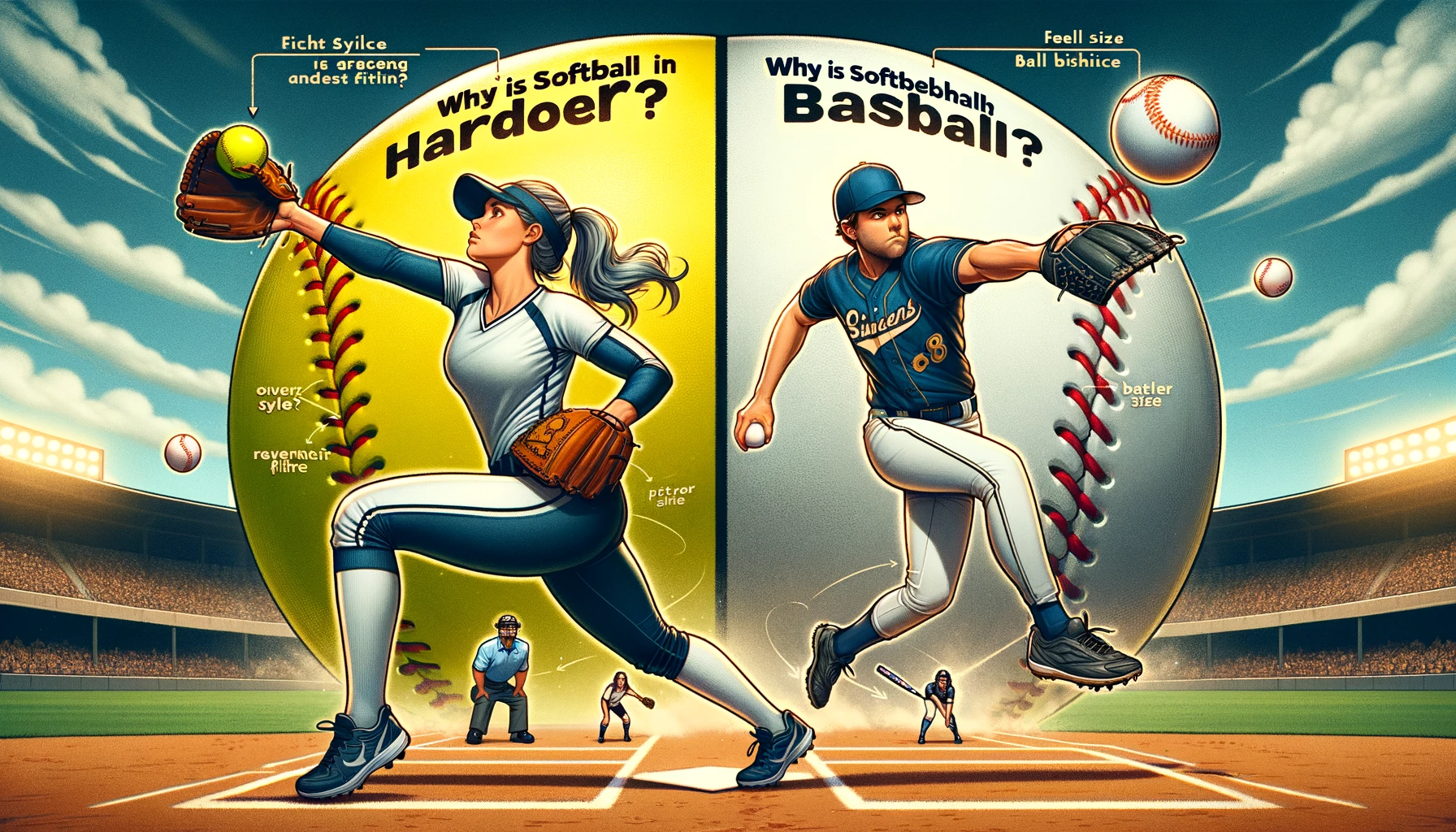Why is Softball Harder than Baseball?
Softball is harder than baseball. Many people think baseball is a more challenging sport, but that’s not the case.
In softball, the ball is bigger, yet the field is smaller, making it harder to react and field the ball. The pitching distance is also shorter, giving the pitcher and batters less time to see the ball.
Additionally, the underhand pitching motion in softball creates unpredictable spins and movements on pitches that are tougher to hit.
In this article, we’ll explore these differences in more detail, helping you understand why many players and fans consider softball a tougher game. You may also read the guide on Is Baseball Harder than Softball
Key Takeaways
- Softball demands an intense training regimen that is often more rigorous than that of baseball, with athletes facing a high in-season commitment and year-round preparation for professional play.
- The skills required in softball are complex and specialized, necessitating peak physical demands, mental alertness, and strategic acumen, often with less transferability to other sports.
- Cultural and historical misconceptions have undervalued softball’s difficulty, overshadowed by baseball’s global influence and the myths surrounding its origins.
- Softball, as a specialized sport, requires a unique set of skills different from field-based sports, challenging the notion that general athleticism translates across all sports.
- Athletic development in softball must be tailored to the sport’s specific demands, debunking the misconception of a one-size-fits-all approach in athletic training.
The Intensity of Training: Softball vs. Baseball
Comparing In-Season Commitments
The in-season commitments of softball and baseball athletes reveal a rigorous schedule that demands exceptional dedication.
Baseball players, for instance, face a daunting in-season routine that includes multiple games per week, daily practices, and additional strength and conditioning sessions.
This intense schedule is further compounded by the academic responsibilities of high school athletes, who must balance 7-8 hours of school and homework with their athletic pursuits.
Softball players, while facing similar demands, often contend with the added pressure of proving their sport’s legitimacy, which can intensify their commitment to training and performance.
The level of planning and adherence to a structured schedule is crucial for athletes aiming to thrive in the season.
By prioritizing non-negotiables such as adequate sleep, school, and sport-specific training, athletes can navigate the challenges of their sports season more effectively.
Ultimately, the commitment to in-season training is a testament to an athlete’s dedication to their sport.
Whether it’s baseball or softball, the willingness to commit and the ability to stick to those commitments can significantly influence an athlete’s success and progression in their sport. You may read the guide on Is Baseball a Contact Sport
Year-Round Preparation for Professional Play
Professional softball players understand that excellence on the field is a result of year-round dedication.
Unlike those aiming for recreational play, professionals must engage in continuous training, where each repetition is a step toward their dream of playing at the highest professional level.
The commitment required is immense, and it’s a clear differentiator between casual and professional athletes.
A well-structured schedule is crucial for athletes who wish to thrive. Prioritizing non-negotiables such as adequate sleep, school or work commitments, and consistent practice sessions is essential.
For instance, a typical day might include:
- 7-8 hours of sleep and relaxation
- 8 hours of school or work
- 2-4 hours dedicated to softball practice
- 3-5 hours of strength training per week
Peak performance cannot be sustained throughout an entire season, which is why athletes and coaches must plan for multiple peaks and incorporate regular assessments to ensure readiness and progress.
Balancing the rigors of professional play with personal life is a challenge, and often, sacrifices in social engagements are necessary to dedicate the required hours for practice, study, and competition.
The Role of Genetics, Training Willingness, and Parental Philosophy
The intersection of genetics, training willingness, and parental philosophy creates a unique landscape in the world of sports.
Genetics certainly plays a role, but it is not the sole determinant of an athlete’s potential.
The willingness to train consistently and the support from parents can significantly influence an athlete’s development.
- Genetics may provide a natural advantage in terms of physique and innate abilities.
- Training willingness is crucial; high-level athletes find ways to overcome obstacles in their path to success.
- Parental philosophy can shape an athlete’s early experiences and attitudes toward sports, potentially encouraging early specialization or promoting a more diverse athletic background.
Ultimately, the combination of these factors can either pave the way for an athlete to reach the top echelons of their sport or lead them to discover their true passion through a broader athletic journey.
Read Also: Why is Baseball So Boring
The Complexity of Skills in Softball

Specialized Skills and Physical Demands
Softball, often perceived as baseball’s less demanding cousin, is a sport that requires a unique blend of specialized skills and intense physical demands.
The sport combines speed, precision, and strategy, necessitating athletes to have fast reflexes and rugged endurance.
Unlike more generalized sports, softball players must hone skills that are highly specific to their positions, such as pitching underhand at high speeds, which involves a complex motion distinct from baseball’s overhand throw.
The physical demands of a softball player are not to be underestimated. Players must be able to sprint short distances quickly, change directions on a dime, and possess hand-eye coordination to hit a fast-moving ball.
The sport’s unique playing surface and smaller field dimensions also contribute to the need for quick reflexes and agility.
Here are some key physical demands of softball:
- Explosive speed for base running and fielding
- Superior hand-eye coordination for batting and catching
- Endurance to withstand the rigors of a fast-paced game
- Strength and flexibility, particularly for pitchers
Behind the deceptive simplicity of softball lies a complex array of challenges that are often overlooked.
The sport’s specialized nature means that the skills developed are tailored specifically to its demands and may not always transfer to other sports contexts. You may read also Do Baseballs Float
Mental Alertness and Game Strategy
Softball demands a high level of mental alertness and strategic thinking, often under intense pressure.
Players must make split-second decisions that can determine the outcome of the game. This requires not only physical readiness but also a sharp mind that can adapt to rapidly changing situations.
Key aspects of mental alertness and game strategy in softball include:
- Understanding the nuances of each play and anticipating opponents’ moves.
- Maintaining focus throughout the game, especially during high-stress situations.
- Developing a deep knowledge of the game’s rules and strategies to make informed decisions quickly.
The mental component of softball is as rigorous as the physical. Athletes must engage in continuous learning and practice to hone their decision-making skills.
This is a testament to the sport’s complexity and the dedication required to excel at the highest levels.
Transferability of Skills to Other Sports
Softball, often perceived as a specialized sport, presents a unique set of skills that are not as readily transferable to other sports as those acquired in field-based sports like soccer or basketball.
The precision and quick reflexes honed in softball, for instance, are highly specific to the sport’s fast-paced nature.
- The underhand pitching technique is a skill almost exclusive to softball and does not directly translate to the overhand throwing mechanics in baseball or football.
- Batting in softball requires different timing and eye-hand coordination due to the closer pitching distance and the ball’s arc trajectory.
- Fielding in softball demands agility and quick decision-making, given the smaller field and faster game speed compared to baseball.
Despite these differences, the physical conditioning and strategic thinking developed in softball can still contribute to an athlete’s overall sports proficiency.
However, the specialized nature of softball means that athletes may need to adapt their skills more significantly when transitioning to or from other sports.
See Also: How Fast Can The Average Person Throw a Baseball
Cultural and Historical Impact on Sport Difficulty

Baseball’s Global Influence and Evolution
Baseball’s ascent to global prominence is a testament to its cultural and economic impact.
By the late 19th century, the United States was not only an industrial powerhouse but also a cradle for modern sports, including the major league baseball itself.
The game’s evolution is often shrouded in myths, such as the tale of Abner Doubleday inventing baseball in 1839. However, a more credible transformation occurred in 1845 with Alexander Cartwright’s formalization of the rules.
The spread of baseball has been closely tied to American influence. In countries where the U.S. had a significant presence, baseball often eclipsed local sports.
For instance, baseball took root in Cuba as early as 1863 and in Japan by 1873, showcasing its international appeal.
The game’s expansion continued through the 20th century, with the major league minor leagues enjoying tremendous popularity across North America and beyond.
Baseball’s global journey reflects the broader narrative of sports globalization, where games like tennis and cricket follow the paths of political and economic influence.
As baseball’s reach extended, it became intertwined with the identity and history of the nations it touched, leaving an indelible mark on the world’s sporting landscape.
Softball’s Unique Challenges and Misconceptions
Softball often falls victim to a myriad of misconceptions, one of which is the perceived simplicity of baseball pitchers rules.
However, the reality is that softball rules can be quite complex, leading to what some refer to as The Umpire Dilemma.
Umpires in softball must make quick decisions, often under the scrutiny of passionate fans who may not fully understand the intricacies of the game.
The sport’s unique challenges extend beyond the rulebook. Softball demands a high level of skill, coordination, and mental agility.
Players must master a variety of specialized skills, such as:
- Quick reflexes for infield play
- Precision pitching with an underhand motion
- Strategic base running
These skills are not easily transferable to other sports, underscoring the specialized nature of softball.
Unlike the one-size-fits-all approach in some sports, softball requires a tailored development plan that takes into account the sport’s specific demands and the athlete’s strengths.
The Myth of Sports Origin and Its Effect on Perception
The origins of a sport can deeply influence its public perception and the respect it commands.
Baseball, with its long and storied history, is often seen as a traditional and prestigious sport.
In contrast, softball, despite its own rich heritage, is sometimes viewed as a lesser counterpart due to its relatively recent development and differences in origin.
- The myth of sports origin can lead to biases in favor of older, more established sports.
- Misconceptions about a sport’s complexity and skill requirements often stem from its history.
- The cultural significance of a sport can overshadow its actual challenges and the athleticism it demands.
Breaking down these origin-based myths is crucial for a fair appreciation of all sports, including softball, which requires a high level of skill and strategic thinking that is often underestimated.
Read Also: How Much Does a Baseball Weigh
The Spectrum of Sports: Specialized vs. Field-Based

Understanding Specialized Sports
Specialized sports like gymnastics, skiing, hockey, swimming, and wrestling focus on specific skills. These skills usually don’t transfer well to other sports.
Each sport needs different physical traits and is played on different surfaces. This affects how athletes train and perform.
Choosing to specialize involves several factors. These include the sport’s specific demands, the athlete’s own interests, and the approach of their support network.
It’s a path marked by significant commitment and potential sacrifices, including time, financial resources, and the breadth of athletic experiences.
- Specialized sports demand unique physical attributes and skill sets.
- The decision to specialize involves careful consideration of various factors.
- Specialization requires commitment and potential sacrifices from athletes and families.
The Benefits of Field-Based Sports
Field-based sports, encompassing activities such as baseball, football, basketball, and soccer, offer a unique set of advantages for athletic development.
These two sports also foster a high degree of skill transferability, enhancing an athlete’s versatility and adaptability across various sports disciplines.
The skills honed in these environments, like spatial awareness and teamwork, are not only crucial within their respective games but also beneficial for cross-training purposes.
Participating in multiple field-based sports can round out an athlete’s skill set, exposing them to diverse coaching philosophies and team dynamics.
This multifaceted approach is particularly valuable for young athletes, as it broadens their athletic, social, and psychological horizons.
By engaging in a variety of sports, they gain access to different social circles and coaching styles, which can enrich their overall experience and widen their perspective on competition and collaboration.
Moreover, the general physical conditioning required in field-based sports can lead to improvements in fitness measures such as increased agility and lower limb strength.
This is especially true for competitive athletes who benefit from the dynamic and physically demanding nature of these sports.
The cross-training effect can contribute to a more robust and well-rounded athletic profile, which is essential for long-term development and success in any sporting endeavor.
How Softball Fits into the Athletic Spectrum
Softball, often perceived as baseball’s counterpart, presents a unique position within the athletic spectrum.
Unlike the broad transferability of skills seen in field-based sports such as soccer or basketball, softball demands a specialized skill set.
The smaller diamonds and closer bases require quick reflexes and rapid decision-making, which are not as easily transferred to other sports.
The sport’s specialized nature is evident in the precise pitching techniques, the strategic placement of center field keepers, and the need for batters to adapt to a variety of pitching styles.
These skills are honed through dedicated practice and are less about general athleticism and more about mastering the nuances of the game.
- The larger and softer ball used in softball changes the dynamics of pitching and hitting.
- The 60-foot baselines, compared to baseball’s 90, alter base running strategies and defensive plays.
- The compact playing field intensifies the game, making every second and every play crucial.
Softball’s distinct challenges carve out its own niche in the athletic world, one that requires athletes to develop a tailored approach to their training and gameplay.
Read Also: What to Wear to a Baseball Game
Conclusion
Some people think softball is easier than baseball, but that’s not true. Softball demands just as much from its players as baseball, if not more.
Players need to be highly committed and skilled to do well in softball. They must be quick, both in thinking and moving, because the game for softball pitchers is fast-paced and the ball comes at them quickly.
Softball fields are different too, affecting how the game is played. These factors make softball a tough sport that requires a lot of effort and talent.
It’s clear that softball is not a simpler sport than baseball, and it should be respected for its unique challenges and the high level of skill it demands.
Frequently Asked Questions
Is softball harder than baseball?
Yes, softball can be considered harder than baseball. The closer pitching distance and faster pitch speed in softball make hitting and reacting more challenging. The smaller softball field and size also requires quicker fielding responses.
What are the 5 differences between softball and baseball?
- Pitching style: Softball uses underhand pitching, while baseball uses overhand.
- Ball size: Softballs are larger and softer than baseballs.
- Field size: Softball fields are smaller, with shorter distances between bases.
- Game length: Softball games typically have 7 innings, whereas baseball games usually have 9 innings.
- Pitching distance: The pitcher’s mound in softball is closer to home plate than in baseball.







